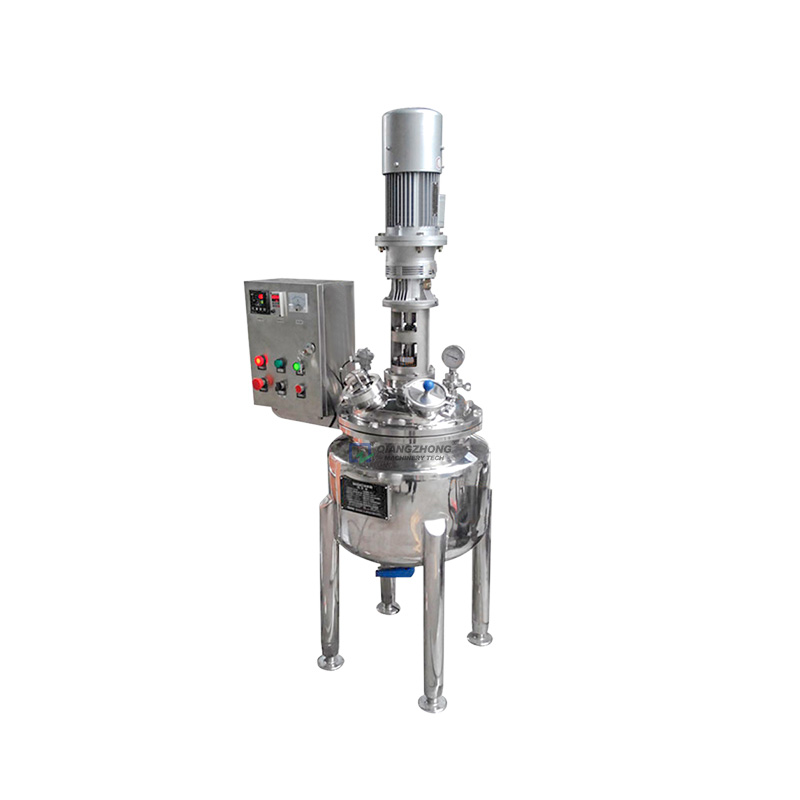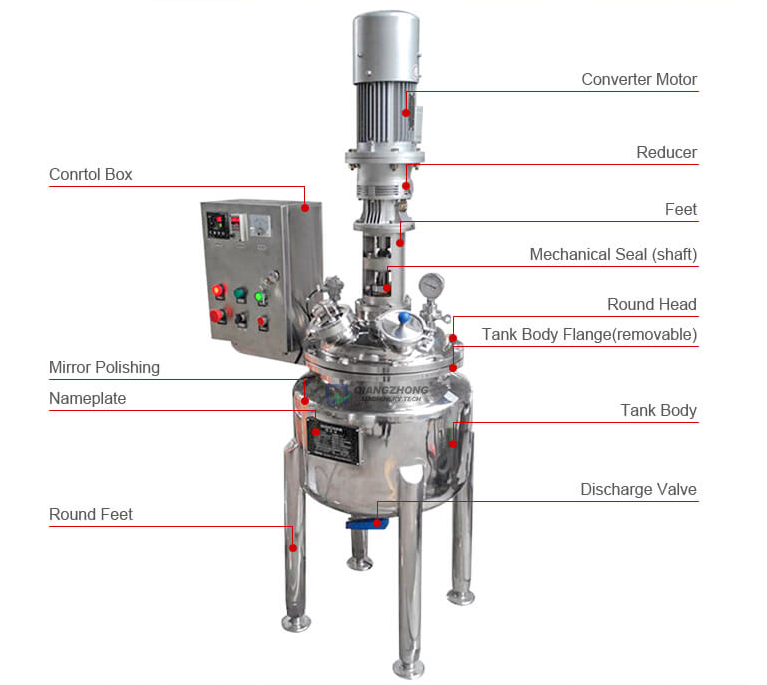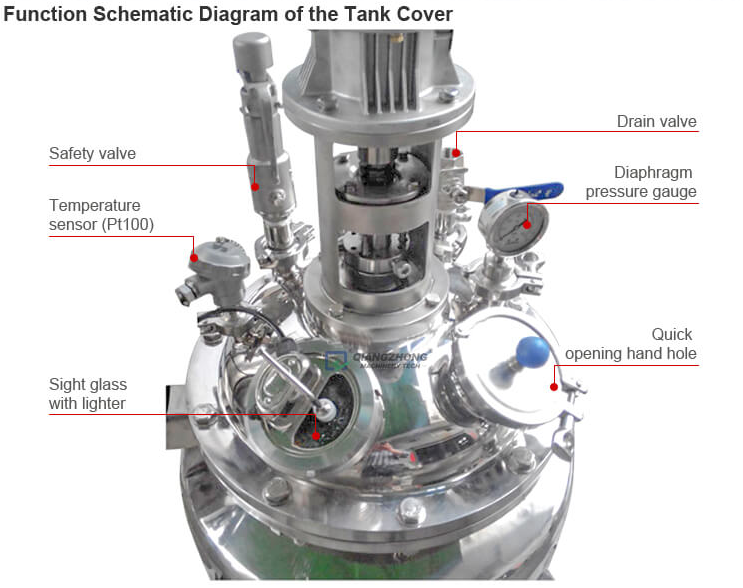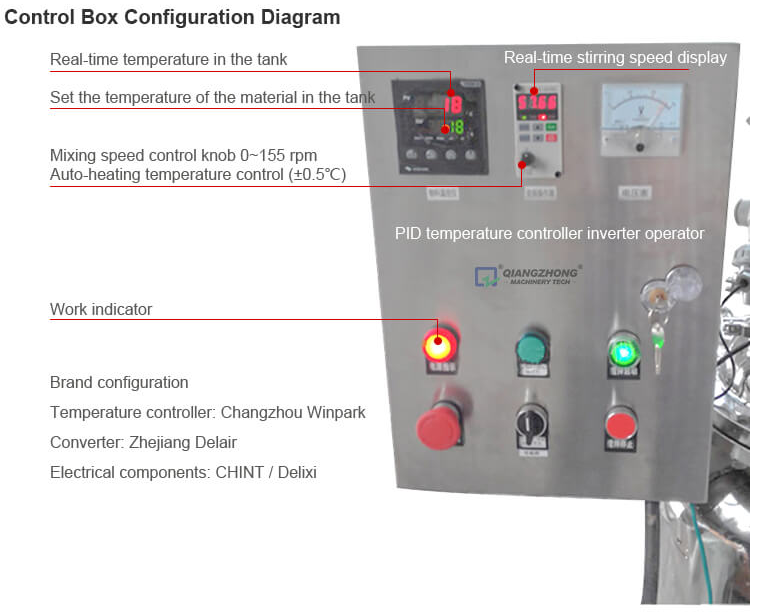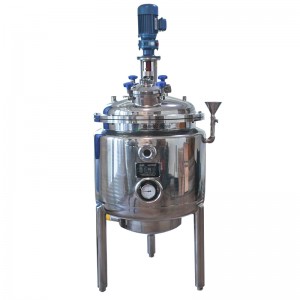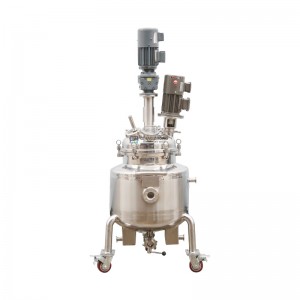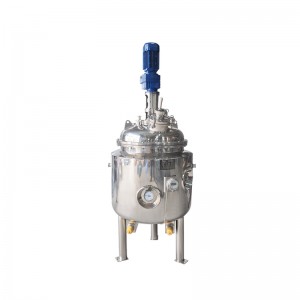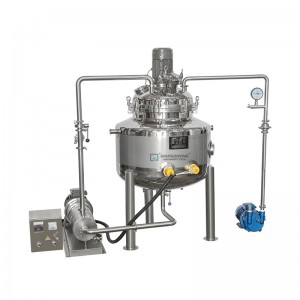Stainless Steel Enzymatic Reaction Tank (35L) Technical Data
Structure: upper and lower elliptical head / three walls / fully sealed structure Nominal volume: 35L (excluding upper head volume)
Working pressure: tank: atmospheric pressure or max. 2MPa / jacket: 0.3MPa Working temperature: tank<130°C; jacket<135°C Mixing power: 0.55KW + 0.03KW / 380V / inverter motor Tank material: stainless steel SUS304
Surface treatment of tank body: mirror polishing (internal surface roughness Ra=0.4[jm)
Sealing type of stirring shaft: mechanical seal Stirring speed range: 0〜155r/min (rpm)
Jacket heat exchange medium: steam / water(need to be)
Inlet and outlet diameter: 032/ 051 (tri-clamp)
Outlet height from ground: 400mm Equipment weight: 133kg (net weight)
Dimensions: length 880mmx width 550mm x height 1650mm (excluding connection size of jacketed steam pipe)
Other nozzle configuration: quick opening feed hole (089), CIP port (021 tube /tri-clampconnection), respirator port, air inlet, jacket inlet and outlet (for steam heating and coolingmedium).
Product Structure
1.Enzymatic definition / enzymatic hydrolysis technology:
That is, decomposition by enzyme catalysis. Enzyme is a kind of biocatalyst, which can decompose various organic polymers and make them into small organic molecules, which is convenient for assimilation of the body. The reaction rate could be raised by the participation of enzyme. Therefore, the decomposition reaction involving enzymes is collectively referred to as "enzymatic reaction'1.
2.Enzymatic hydrolysis tank function:
It works as an enzyme reaction device for a specific enzyme and a substance to be sufficiently stirred under suitable temperature and pH conditions, and to be enzymatically hydrolyzed and converted into a substance, for example, hydrolyzing starch to glucose with amylase.
3.Application range:
Widely used in food, beverage, bioengineering, pharmaceutical and other industries.
4.Main functions:
Heating, cooling, insulation, stirring, inactivating enzyme, etc.
5.The capacity and classification:
Experimental type: 15L, 20L, 25L, 40L, 50L, 80L, 100L and other series specifications.
Pilot type: 200L, 300L, 400L, 500L, 800L, 1000L and other series specifications.
Scale production type: 2000L, 3000L, 4000L, 5000L, 8000L, 10000L-50000L, etc.
6.Accessory configuration:
Quick-opening sanitary hand hole, sight glass, thermometer (liquid crystal digital display or pointer type), respirator, CIP cleaner, liquid inlet and outlet, sampling port, pH meter port, SIP sterilization port (optional), liquid level gauge (optional), jacket inlet and outlet, etc.
Stirring device operating state: Stirring drive system load operation is stable without abnormal noise, load running noise < 40 dB (A) [national standards <75dB (A)]. Greatly reduce the noise pollution in the workshop and create good working conditions for operators.
7.Material:
Stainless steel SUS304 or SUS316L
8.Working conditions:
The ancillary facilities are required including steam (or hot water), water, electricity, etc. Note: In some special cases, for example there is no heat source (steam or hot water) available for the enzymatic hydrolysis tank of less than 500L, the electric heating type is also workable, but it is not recommended for normal conditions.
Stainless steel enzymatic reaction tank instructions
1.Overview: The design and manufacture of the tank machine conforms to the requirements of the 2010 edition of theuGMP”specification. It is economical, sanitary, safe, efficient, easy to be washed and cleaned.
It can meet the following process requirements:
1 )• Loading range: 8L 〜30L
2). Applicable pressure range in the tank: 0-0.3MPa
3). Applicable temperature range: (TC ~ 130°C
4). Applicable materials: powder + liquid, liquid + liquid, material in high viscosity or high concentration.
2.Equipment structure: upper and lower round head and bottom discharge.
3.Main function of the tank: heating (the jacket is heated by steam, the material temperature in the tank is automatically controlled), cooling, insulation, stirring, and enzyme inhibition (enzyme inactivation).
It can meet the following process requirements:
1 )• Loading range: 8L 〜30L
2). Applicable pressure range in the tank: 0〜0.3MPa
3). Applicable temperature range: 0°C ~ 13CTC
4). Applicable materials: powder + liquid, liquid + liquid, material in high viscosity or high concentration.
2.Equipment structure: upper and lower round head and bottom discharge.
3.Main function of the tank: heating (the jacket is heated by steam, the material temperature in the tank is automatically controlled), cooling, insulation, stirring, and enzyme inhibition (enzyme inactivation).
It has the following features:
1). The tank body, the parts in contact with the material, and other materials are all made of stainless steel 304.
2). The inner and outer cylinders are mirror polished, and the inner liner roughness Ra<0.4um, glossy and beautiful.
3). The mixing device adopts the combination of converter motor and cycloidal speed reducer (speed range: CM 55r/min), meeting the requirements of different loading and different process for mixing, convenient speed regulation, and online real-time reading the data of stirring speed, output power, output current, etc.
4). Stirring device operation state: The mixing of the liquid in the tank is fast and uniform, the load of the stirring transmission system is running smoothly, and the load operation noise is <35dB(A) [far less than the national related standard <75dB(A)], greatly reducing the noise pollution.
5). The agitator shaft seal is sanitary, wear-resistant and pressure-resistant mechanical seal, safe and reliable.
6). The top of the tank is equipped with a feeding port for convenient feeding; the built-in 360° rotary ball cleaner (CIP) ensures thorough cleaning. The circular mirror on the top of the tank has a scraper, which can effectively scrape the water vapor generated by the mirror glass surface due to the temperature rise in the tank, so that the material state in the tank can be clearly observed. The bottom discharge port can ensure that the material in the tank is discharged more cleanly without any residual liquid.
7). The heating temperature of the material in the tank can be automatically controlled, and the temperature sensitivity is high (±1°C). The P旧 intelligent temperature con_er and Pt100 sensor are adopted, easy to set up, economical and durable.
8). All process interfaces are short, quick-fit connections, very smooth, and also easy to clean, easy to assemble and disassemble.

